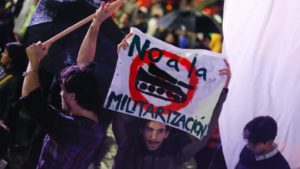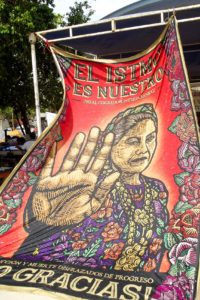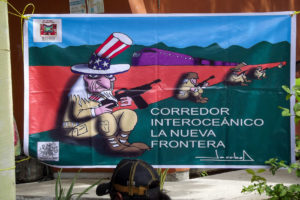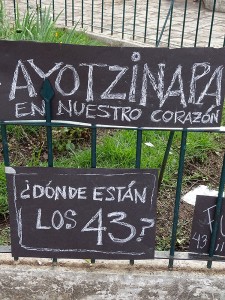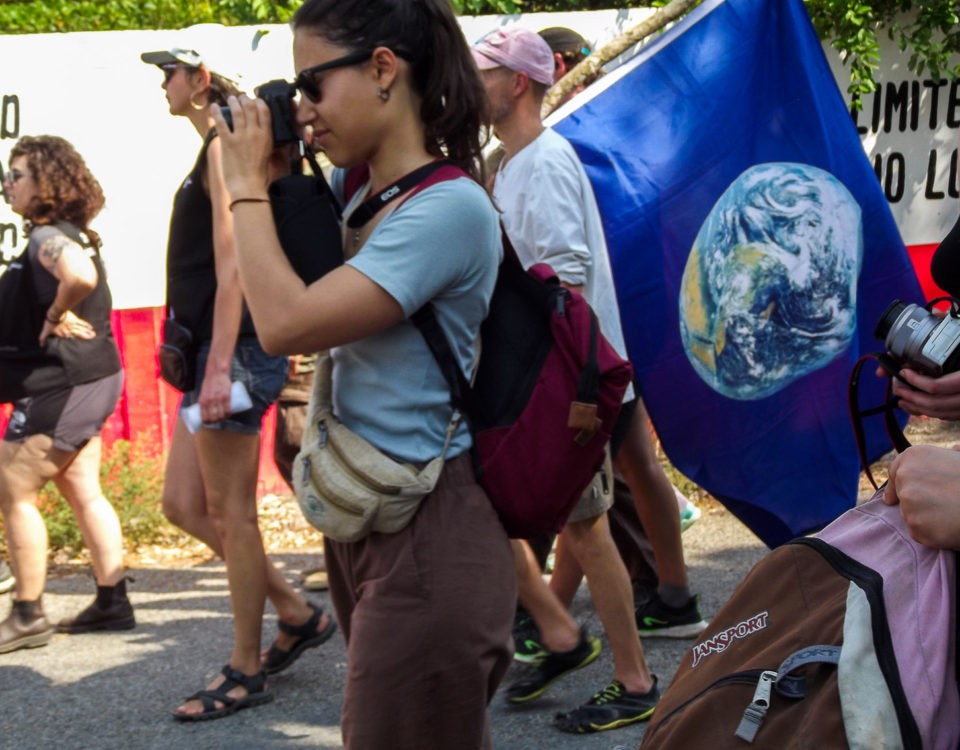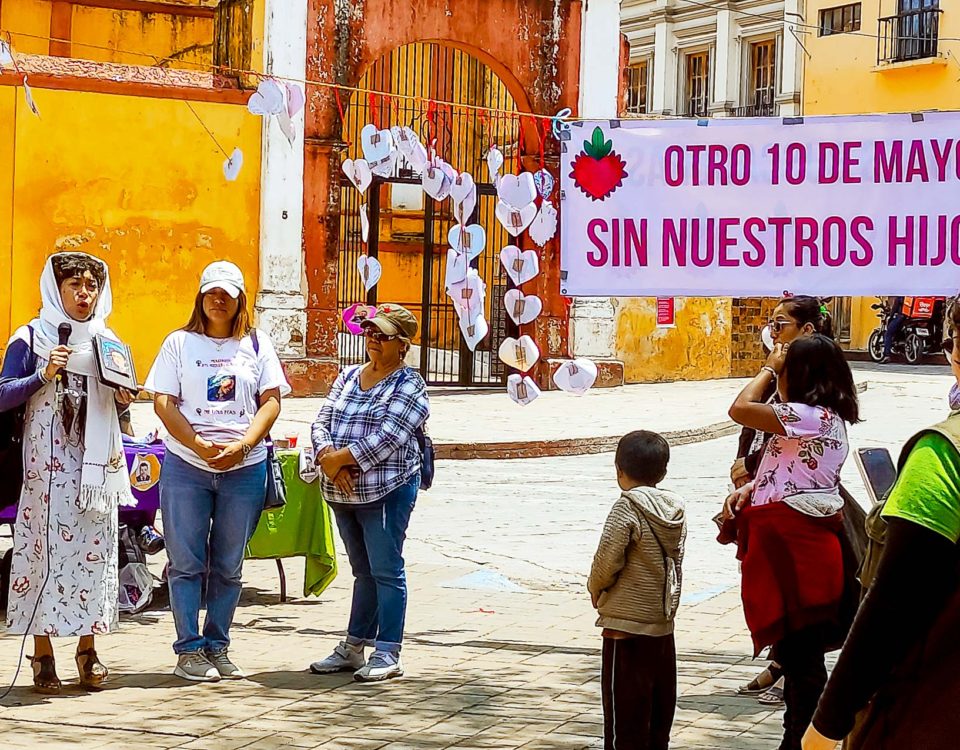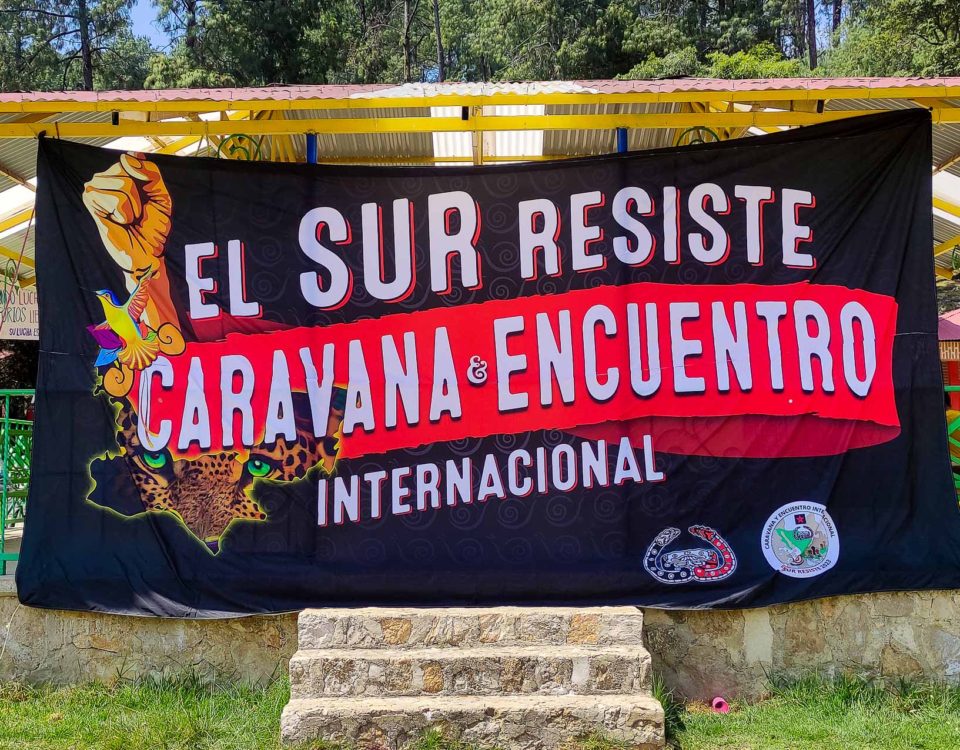2022
14/03/2023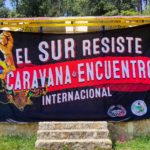
FOCUS: Megaprojects in the Mexican Southeast; Resistance of the Original Peoples in Defense of Territory and Life
17/06/2023L ast March, Amnesty International presented its annual report, in which it addresses the human rights crisis in Mexico and highlights the lack of government action to address it.
It reported that, in 2022, the National Human Rights Commission (CNDH) received 476 complaints against the National Guard (GN) and 404 against the Secretary of National Defense (SEDENA) for human rights violations, such as torture, homicides, forced disappearances and arbitrary arrests. It stressed that an excessive use of public force continues to be observed. In addition, it pointed out that last year the GN occupied 227 areas that were normally the jurisdiction of the civil authorities, of which 148 (65.1%) had nothing to do with public safety.
Putting a stop to this trend, in April, there was a resolution of the Supreme Court of Justice of the Nation (SCJN) that declared invalid the operational and administrative transfer of the National Guard (GN) to the Secretary of National Defense (SEDENA). This measure was considered unconstitutional because it implied that the GN lost its character as a civilian police force. This transfer had been approved by Congress in September 2022. The SCJN also determined that the Executive has until January 1st, 2024 to return the National Guard to the command of the Secretary of Security and Citizen Protection. Since this ruling, President Andres Manuel Lopez Obrador (AMLO) has attacked the ministers of the SCJN. In addition, he informed that he will present a constitutional reform proposal in September 2024 to allow the GN to once again be under military command.
For his part, the United Nations High Commissioner for Human Rights in Mexico, Volker Türk, urged the authorities to comply with the Supreme Court ruling. He reiterated the importance of guaranteeing the civilian nature of the GN “in accordance with the Mexican Constitution and international human rights standards.” This is when the armed forces should only be deployed “in exceptional circumstances, subordinate to the civil authorities and always under the effective supervision of independent civil bodies.”
One of the new fields in which the Mexican Army is having a greater presence is construction, protection and exploitation of megaprojects promoted by the federal government, and stopping expressions of non-conformity towards them.

Andrés Manuel López Obrador during the morning conference where the design of the Mayan Train convoys was presented © Cuartoscuro
However, in March, a hearing by the International Tribunal for the Rights of Nature in the Yucatan peninsula was held “for the misnamed Maya Train, a rail transport megaproject that puts Maya ecosystems and communities in grave danger of destruction.” Affected communities and experts pointed out, among other things, the deforestation of almost nine million trees; the growth of agro-industries; direct impacts to the water of the ecosystem of the peninsula; the violation of the Escazu agreements on environmental protection; and the privatization and division of ejido territories. “We demand the immediate demilitarization of the territory, we make an urgent call to the state, to all human rights defenders in Mexico and to regional and international organizations (…) to guarantee the lives of all those who question the Maya Train and the connected projects”, ruled the court that requested the immediate suspension of the Maya Train due to the ecocide and ethnocide alert.
Regarding mining companies, in May, the reforms to the Mining Laws were published in the Official Gazette of the Federation; of National Waters; Ecological Balance and Environmental Protection. They determine that from now on concessions will be valid for a maximum of 80 years (instead of the 100 years foreseen in the law that was reformed). In the advances, the granting of concessions in protected natural areas, where the population is put at risk, and in areas without water availability, will be prohibited. The preferential nature of mining activity over any use or exploitation of the land was also eliminated. However, the Mexican Network of People Affected by Mining (REMA) questioned the approved laws, considering that it was nothing more than “legally ‘leveling’ the conditions to make mining a ‘better managed’ business or ‘ fairer'”. It stressed that “any reform to the mining law that does not propose the prohibition and planned closure of this harmful activity in the country (…) is a simulation that will only continue to legitimize and give rise to the expansion of the extractive model.”
Worsening of Safety of Journalists and Human Rights Defenders Continues
In March, Article 19 presented its annual report “Voices against Indifference.” It documented that “in the last four years of the government that established itself as a “transformer”, the panorama of freedom of expression continues with a marked tendency of deterioration.” In 2022, the organization “registered 696 attacks against the press (…). The 12 murders recorded last year also closed the deadliest year for the press along with 2017.” 42.53% of the cases of aggressions were committed by the authorities. In addition, Article 19 documented that “on at least 176 occasions the Executive made stigmatizing comments to the media, journalists, and even civil society organizations.” The report also notes “concerns about the militarization of the country and the opacity that surrounds the armed forces, particularly around espionage actions as a tool for intimidation and threats against journalists and human rights defenders.” Impunity is another axis of concern: “from 2010 (…) to December 2022, of a total of 1,592 inquiries for crimes against journalists, only 32 sentences have been obtained.”
During the month of April, Front Line Defenders released its 2022 annual report, which reveals that 45 human rights defenders were reported murdered in Mexico. In the same month, the Mexican Center for Environmental Law (CEMDA) reported that during the past year at least 24 cases of murdered environmental defenders were registered. These tragic events add to a total of 82 environmental defenders murdered since the beginning of President AMLO’s administration. Of the 582 documented attacks, 56% were directed against members of indigenous peoples and comparable communities. Among the entities with the most lethal attacks are Guerrero, followed by Chihuahua and Oaxaca. 45% of the attacks were perpetrated by some authority. Organized crime represented 13% of the cases, while in 21% of them the perpetrator is unknown.
Migration: Another “Tragedy”
In March, a fire broke out at the facilities of the National Migration Institute (INM) in Ciudad Juarez, a city on the border with the United States, with a death toll of 40. AMLO declared that the migrants, arrested this same day for alleged disturbances on public roads, decided to burn mats in protest when they thought they were going to be deported. UN Secretary General Antonio Guterres called for a thorough investigation as the US State Department warned that “this tragedy is a heartbreaking reminder of the risks migrants and refugees face around the world.” For its part, Refugees International affirmed that “INAMI [INM] has a long history of abuses against migrants in Mexico, and greater accountability for these abuses could have prevented this tragedy.”
In April, approximately four thousand migrants from Central and South America and other countries left Chiapas, on a Via Crucis heading to Mexico City, to “highlight the ordeal of migrants in Mexico.” Among the demands of the Via Crucis was that the INM be demilitarized; to ensure that those guilty in the case of the violent death of 40 migrants in Ciudad Juarez are tried, along with INM commissioner Francisco Garduño; and that the “immigration prisons” be closed.
Search To Build Alternatives in the Midst of Adversity
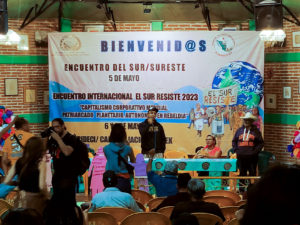
Meeting “World Corporate Capitalism, Planetary Patriarchy, Autonomies in Rebellion”, San Cristóbal de Las Casas, May 2023 © SIPAZ
Despite a dark outlook, several sectors are seeking to continue building alternatives. In March, the National Peace Conference convened by 206 organizations, collectives and universities took place, in which the participants shared concerns and proposals in the context of violence. “Here is the urgent agenda of a country riddled with violence: break the isolation and unite those who suffer from it and resist it despite everything. It is not and cannot be an electoral agenda. It is a task for groups and organizations that perhaps, hopefully, will begin to recognize and embrace each other”, declared Mauricio Merino, coordinator of Nosotrxs and one of the main promoters of this initiative.
Between April and May, different organizations of indigenous peoples, most of them part of the National Indigenous Congress (CNI) began a National and International Caravan El Sur Resiste (The South Resists) in Pijijiapan, Chiapas, to meet in the territories they defend and to join their processes of struggle. After Oaxaca, it passed through Veracruz, Tabasco, Yucatan, Quintana Roo and Campeche. The tour ended in San Cristobal de Las Casas, Chiapas, where an international encounter was convened with representatives of other indigenous communities in Mexico and the continent (see Focus).
In April, the Conference of the Mexican Episcopate (CEM), the Society of Jesus in Mexico and the Conference of Major Superiors of the Religious of Mexico (CIRM) called for a National Dialogue for Peace, which will take place in September in Puebla, with the objective of elaborating a National Peace Agenda. They declared that “it is time to convene specialists, to learn about the best local practices, listen to the victims, the indigenous people, the migrants, take into account those who have managed to sustain low crime rates in the territories, the churches.”
CHIAPAS: Surge of Complaints Due to General Increase in Violence
In April, the bishops of the diocese of San Cristobal de Las Casas expressed their “concern about the social decomposition that is increasing due to generalized violence.” As regards elements of concern, they spoke of “the territorial dispute that is deteriorating the social fabric more and more, the excessive exploitation of natural resources (reactivation of mining extraction; illegal sale of wood, stone material, gasoline, etc.), the manipulation and the stripping of the dignity of our peoples, psychological warfare, femicides, the detriment of community strength, the criminalization of peaceful struggles and resistance, as well as the pastoral activities of our diocese.”
The diocese also pointed out “the strong impunity that prevails in the state, the increase in insecurity and violence overwhelmed by crime cells, the political-legal system that criminalizes human rights defenders, the lack of access to full justice, the infiltration of people in acts of worship and in meetings of servants, the fabrication of crimes, the lack of interest in the reconstruction of the social fabric by the authorities.”
In this same sense, Indigenous Peoples Rights International (IPRI) and Front Line Defenders shared the conclusions they drew from a visit to Chiapas at the end of March. They declared that they had identified “a clear pattern of criminalization against indigenous defenders who defend environmental rights, territory, autonomy and self-determination.” They also observed “the lack of lasting solutions to agrarian and territorial conflicts in the communities, which continues to represent a high risk for defenders and continues to perpetuate the decomposition of the social fabric (…). This has been aggravated by the current situation of land dispossession in the context of the militarization of the region and by the dispute over territorial control (…) by organized crime groups.” On the other hand, they noted with concern “the lack of timely interventions by the authorities” in “a context of proliferation and diversification of armed groups, which has worsened a complex situation inherited from the paramilitary context of the 1990s and the continuous impunity.”
In May, the Fray Bartolome de Las Casas Human Rights Center presented the report “Chiapas, a Disaster. Between Criminal Violence and State Complicity. “We are in the midst of a context of continuity of generalized violence, of wars that hurt humanity. In Chiapas this is reflected in a myriad of notable interactions between organized crime, armed groups, and obvious links to governments and businesses. Its impacts reproduce systematic violations of human rights, in a context where the State (…) is ignorant, permissive and acquiescent in the face of the current generalized violence and the multiple layers of impunity that historically add up”, the report states.
In this last aspect, not even the touristic San Cristobal de Las Casas turned out to be an exception: in April, in a video recording shared on social networks, a group of around 50 hooded, armed and uniformed men indicated that San Cristobal, Chamula and Betania are free and do not want any cartel in this area. They indicated that they are already watching and that, as self-defense groups, “will take care of and guard peace.” “We have already located all the leaders who have sold themselves and we know who they are. So stop supporting organized crime or you will have to face the consequences”, they said.
In mid-April, the murder of Geronimo Ruiz Lopez, leader of one of the groups of artisans in the Santo Domingo market, was reported. He and his cousin Narciso Ruiz headed the Association of Traditional Market Tenants of San Cristobal de Las Casas (ALMETRACH). It is suspected that both were linked to shock groups known as “motonetos”. For more than eight hours, there were mobilizations of armed people and firearms were used at various points in the city. The burning of houses, blockades in some streets and the murder of two people were also reported.
Subsequently, 25 civil organizations and networks expressed their “deep concern” at the “excessive violence” in San Cristobal de Las Casas, linked to the growing presence of armed groups, a situation in which “it is evident that factual powers use them through acts of terror, to control the population and strategic territory for the legal and illegal economies of organized crime.” They regretted that after what happened, the Municipal President of San Cristobal de Las Casas broadcast “a discriminatory message against indigenous people and young people from the periphery, who he held responsable for the violence, thereby promoting stigmatization and criminalization.” In addition, they warned about the fact that there are “various signs of collusion, minimization, or inaction [on the part of the authorities], which increase the risk and defenselessness for the victims and society in general.” They called on the Mexican State to “generate alternatives from society with a view to building lasting peace.”
OAXACA: The Isthmus, Main Hot Spot
In recent months, communities, organizations, and activists denounced the criminalization and threats against “the indigenous people of the Tehuantepec Isthmus of who fight for their rights, and who have been mobilizing in the area of Mogoñe Viejo, municipality of San Juan Guichicovi, Oaxaca, who have repeatedly been harassed by elements of the Secretary of the Navy”, this in the framework of their fight against the Transisthmic Corridor, industrial parks and for the defense of the territory. They expressed particular concern for the safety and integrity of Carlos Beas Torres, leader of the Union of Indigenous Communities of the North Zone of the Isthmus (UCIZONI), whom journalists have pointed out “as responsible for the mobilizations and linking his organization with the organized crime.”
In April, the environmental defender and municipal agent of the 20 de Noviembre El Morro community, municipality of San Francisco Ixhuatan, Felix Vicente Cruz, was murdered. The Office in Mexico of the United Nations High Commissioner for Human Rights (UNHCHR) stressed that he is the second defender assassinated in San Francisco Ixhuatan of which it is aware. UCIZONI highlighted the work carried out by Vicente Cruz in defense of land and territory in the Isthmus, in particular his participation in actions against the high electricity rates and in rejection of the Transisthmic Corridor project. Likewise, the Assembly of the Indigenous Peoples of the Isthmus in Defense of Land and Territory declared that “this act of violence against those of us who defend the land, territory, and rights occurs in the context of the imposition of the Interoceanic Corridor, to the detriment of the organizations that reject the imposition, the dispossession, looting, contamination and death of our natural assets and territory that this project will bring to the Isthmus.”
In other aspects of concern, in April, Consorcio Oaxaca denounced that “almost five months after Salomon Jara Cruz’s administration began, in Oaxaca femicides continue to increase in total impunity, institutional indifference and under the protection of the State Executive, who with his omission as current ruler has perpetuated a State policy that not only forgets and revictimizes women, but also overlaps gender violence.¨ It documented that from December 1st to date, “at least 50 murders of women have been recorded.”
In May, Consorcio Oaxaca urged the state government to guarantee freedom of expression in Oaxaca, the state in fifth place for the most murders of journalists and second for the most murders of human rights defenders. It highlighted that Oaxaca ranks second at the national level for people incorporated into the federal Protection Mechanism, with a total of 155 people: 131 defenders and 24 journalists. Despite this, the insecurity faced by defenders and journalists remains critical and the role of the state government, instead of helping, has contributed to their stigmatization and vulnerability. In particular, Consorcio condemned that “from the state administration public statements are made that violate the exercise of journalism.”
GUERRERO: “Shipwreck for the Truth”
In February, La Montaña Tlachinollan Human Rights Center presented its report “43: The Shipwreck for the Truth”, in reference to the case of the forced disappearance of 43 students from the Normal Rural School of Ayotzinapa in 2014. Given the most emblematic case of the human rights crisis in Guerrero, the director of Tlachinollan, Abel Barrera, explained: “Unfortunately, there is a shipwreck for the truth. There has been a turnaround in recent months. (…) the political will of the authorities is needed, the commitment of the Attorney General of the Republic to deepen the investigations and of the elites of the Mexican Army to be able to provide all the information related to the disappearance of the 43. We see that there has been reluctance, there are already reports from the Undersecretariat for Human Rights as well as from the IGIE that give more elements of responsibility that point to the Army as the presumed perpetrator (…). However, the doors remain closed.¨
Although “the central theme of this book is forced disappearances in Guerrero, those of the past and the current ones”, the report addresses other issues. Violence in the first place, when “we see an expansion of organized crime groups and a weakening of security institutions, not to say a retreat, which prevents the population from being guaranteed security. In the seven regions of the state there are more than 22 organized crime groups that are usurping power in terms of territory and presence in the municipalities.¨
Similar to the case of Ayotzinapa, in February, on Army Day in Mexico, relatives of victims of the Dirty War protested in front of the facilities of the Sixth Battalion of Combat Engineers, in Chilpancingo. Their demands: that the Mexican Air Force disclose the names and the number of people who were thrown into the sea on the death flights in this context of repression; and punish those who ordered these actions that, they estimate, led to the disappearance of more than 600 people. They also demanded the dismissal of the current Attorney General of the Republic, Alejandro Gertz Manero. They declared that, to date, “investigations into the facts are not advancing, because the Secretary of National Defense prevents it and protects the criminal soldiers who are still alive.”
On questions of greater hope, in March, a sentence of 20 years in prison was handed down against a member of the Mexican Army for the crimes of torture, rape, robbery and trespassing committed against Ines Fernandez Ortega, an indigenous woman from the municipality of Ayutla de los Libres 21 years ago. In 2010, the Inter-American Court of Human Rights handed down a sentence against the Mexican State, forcing it to punish those responsible and make full reparation for the damage. A small victory when, during all these years, Ines and her family were victims of threats and reprisals, even her sister was murdered, a case that to date remains unpunished.
On another note, in April, in San Luis Acatlan, an assembly of the Regional Council of Agrarian Authorities in Defense of the Territory (CRAADET) was held. It decided to deny permits that could enable prospecting, exploration and exploitation of mining concessions. The Mexican Network of People Affected by Mining (REMA) highlighted that the peoples of the Mountains and the Costa Chica have been in dialogue for ten years in building a collective defense of territory, unlike the “false consent processes” organized by the government where in four hours decisions are made that “change the lives of the communities forever.” It recalled that in Guerrero there are five mines operating, 12 cartels involved and at least 35,000 people displaced by mining disputes.

